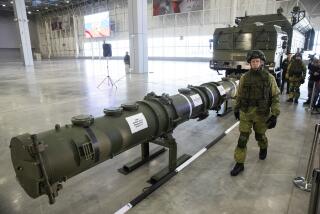For NATO Allies, Political Relief but Military Concerns
WASHINGTON — America’s North Atlantic Treaty Organization allies in Europe will be the first to feel the practical effects of the treaty signed Tuesday between the United States and the Soviet Union to ban ground-launched, medium- and shorter-range nuclear weapons worldwide.
Thirty days after the treaty has been ratified by the U.S. Senate and the Supreme Soviet, Soviet military inspectors will begin arriving at bases in Britain, West Germany, Belgium and Italy to count and verify the deployment of 429 U.S. cruise and Pershing 2 missiles that have been shipped to Europe since December, 1983.
Within three years, all of this missile hardware, which cost between $7 billion and $9 billion to produce and deploy, will have to be removed under the treaty’s provisions. The missiles were paid for by the United States, while the sites and support facilities were supplied by the European NATO members.
Focus of Protests
Politically, there will be a sigh of relief among European officials when the missiles begin to disappear, because the weapons have been the focus of many anti-nuclear protests.
In particular, the Dutch government is breathing more easily, since it has had the most difficult political struggle of all NATO nations in maneuvering for parliamentary acceptance of deployment of its quota of cruise missiles. Now it will not have to receive them at all, even though work on the sites is well advanced. Further deployment of any more U.S. missiles in Europe was halted by action of the NATO defense ministers at their semiannual meeting in Brussels two weeks ago.
But from the standpoint of military defense and strategic considerations, the European reaction to the nuclear arms control agreement is more guarded.
Conventional Superiority
While the two superpowers are concentrating on moving ahead toward reductions in long-range nuclear missiles, the United States’ Western allies are most concerned about the Soviets’ vast superiority in conventional forces in their region. They considered the soon-to-be-banned medium-range missiles a deterrent against an invasion.
“While we welcome a treaty reducing intermediate-range nuclear forces, we now have very much to do toward creating stability on the conventional side,” West German Gen. Wolfgang Altenburg, chairman of the NATO Chiefs of Staff Military Committee, said at a meeting of NATO ministers in Brussels last week. “There are hardly any promising prospects in the conventional field, and that is the main threat and the main problem.”
Similarly, British Prime Minister Margaret Thatcher bluntly told Soviet leader Mikhail S. Gorbachev on Monday, during his stop-over in Britain on his way to Washington, that “there is no further scope for further nuclear reduction in Europe” without cuts in conventional and chemical weapons.
With about 4,000 American nuclear warheads still left in Western Europe after the withdrawal of the cruise and Pershing missiles, there is not much concern about American “decoupling” or desertion of the NATO alliance. But there is concern about maintaining an adequate force to meet an attack without resorting to nuclear weapons.
With the medium-range missiles being scrapped, the Europeans will not count the superpower summit a success unless it provides some impetus for progress toward reductions in Soviet conventional forces.
More to Read
Sign up for Essential California
The most important California stories and recommendations in your inbox every morning.
You may occasionally receive promotional content from the Los Angeles Times.










